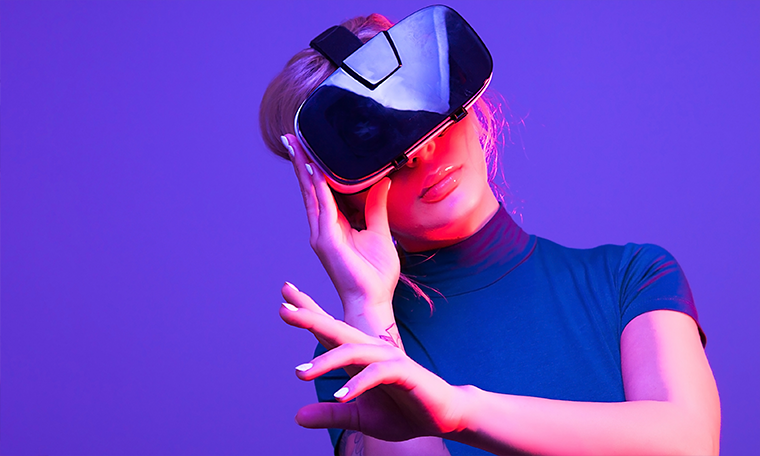Virtual reality for learning is no longer an abstract concept — it’s here. It’s already being used to train surgeons, help retail workers prepare for Black Friday craziness, keep construction workers safer and even help quarterbacks improve their game.
According to one expert, virtual reality is the first real disruptive technology in learning, breaking away from the flat-screen mode of learning and hacking the senses to enter a three-dimensional world filled with sights and sound.
“It will be on par with the change that the internet brought to the industry, if not bigger,” said Anders Gronstedt, president of digital training consultancy The Gronstedt Group.
The internet, paired with personal computers and mobile devices, has until now mainly taken the traditional classroom model for learning and repurposed it in a new medium, he said. Virtual reality has the potential to fundamentally change how learning happens. By strapping on a VR headset, learners step into an immersive computer-generated world that can serve as a virtual rehearsal space for learning.
Gronstedt said VR in its current form works best for industries where special technical training is needed such as construction, manufacturing, health care, retail and the military. But as this emerging technology becomes more ingrained in our lives, CLOs should consider how it can be used more broadly and strategically for employee development.
From Stanford to STRIVR
One of the companies leading the charge in developing learning applications for virtual reality is San Francisco Bay-area based STRIVR.
When Derek Belch was a graduate student and assistant football coach at Stanford University, he had an idea. Working with Stanford professor Jeremy Bailenson in the Virtual Human Interaction Lab at Stanford, they wanted to see how VR could be used to improve the play of the university’s football team.
That early work led Belch to start STRIVR, a VR training company that works with U.S. professional sports leagues as well as corporate clients including Walmart and Google. He now serves as CEO of the company.
Danny Belch, Derek’s brother and STRIVR’s vice president of marketing, said VR allows athletes to engage in extra practice without putting additional strain on their bodies. Those benefits reach outside of sports. Athletes have to look for specific visual, mental and spatial cues and similar training is required for some corporate jobs. Danny Belch said the best opportunities for VR can be identified by using the acronym RIDE: rare, impossible, dangerous or expensive.
Danny Belch said companies that work with STRIVR sometimes know exactly what they want to do with VR while others simply know they want to use VR and need help figuring out how. There are two options for them. STRIVR can capture footage using six GoPro cameras welded together to make a 360-degree video camera and use that footage to create custom VR experiences or STRIVR can provide the tools to the company to capture its own content.
In both scenarios, data is recorded about where users look while wearing the headset and how long they look at each location. “It’s such a rich data set about true behavior,” Danny Belch said. “You’re not watching a 2-D video screen or clicking on buttons. You’re actually learning as if you were doing, so the data of the behavior is tracked.”
Danny Belch said companies do different things with the data. Some use it to provide feedback to individuals. For example, they might ask an employee, “Why are you looking over there? You missed all these customers over here,” or say, “Great job, you scanned every possible hazard.” Companies also are aggregating data to see how a class of learners is performing overall. If a majority make similar mistakes that helps the company identify a potential instructional problem.
Going forward, Danny Belch said the data will be used more in evaluations either as part of the interview process or as a competitive benchmarking system for current employees.
VR for the OR and Beyond
While VR is spreading quickly in some industries, others like the insurance industry have been slower to get on board. Farmers Insurance, however, has started experimenting with VR headsets like Facebook’s Oculus Rift for onboarding claims adjusters.
One of the biggest challenges adjusters face is the real world experience necessary to learn and improve, said Jessica DeCanio, director at The University of Farmers. The university built two full-size homes as learning labs so adjusters can gain that experience but DeCanio said it’s not ideal because it’s the same house with the same rooms and same damage every time. Farmers decided to invest in VR training in 2016 when the technology showed swift advancements, prices came down and equipment became more accessible.
The company hired Talespin, a VR production company, to create a digital home with six different floor plans and several options for types of damage that can be applied.
“Claims adjusters can capture literally thousands of different experiences before they’re ever even in a real customer’s home,” DeCanio said. “That helps build up their confidence, their skill set and ultimately their empathy with the customer.”
Although it began as a pilot program, Farmers plans to build the VR platform into all property onboarding programs based on feedback. Pilot participants said they wished they had gone through the training earlier and appreciated being able to slow down, think decisions through and ask questions in the moment.
Farmers’ VR setup also offers a basic and advanced level allowing employees to practice at different proficiencies. “The gamified effects of VR make it something that’s appealing to people who have been on the job for a while to test their knowledge with a competitive angle,” DeCanio said.
Similar to STRIVR, Farmers’ VR sessions can be recorded so there’s an opportunity to use them from a coaching standpoint to debrief and discuss the effects decisions might have on the claim or customer experience, DeCanio said.
While most corporate training involves using headsets like Oculus Rift, the medical industry is using VR in a different way. At the Northwestern University Feinberg School of Medicine in Chicago, Dr. Jeffrey Barsuk said they work with simulations and VR, which often involves three-dimensional work with the hands but a two-dimensional image on screen.
One such simulator is a colonoscopy machine for aspiring gastrointestinal doctors. Barsuk said the machine has significant upsides. After using the machine, it’s as if the resident has already done between 50 and 80 procedures on a real patient, he said. VR machines are also used to train for laparoscopic surgery-based procedures such as removing the gallbladder or appendix.
Eric Hungness, a Northwestern surgeon, said a major benefit of medical VR is standardization. “The residents experience the same thing every time,” he said. “The computer can track motion and can define and look for errors.”
One downside Hungness identified is the artificiality of VR. “When you’re doing real surgery, you get feedback from the tissue,” he said. “You touch the tissue and you feel a resistance against your hands. How do you simulate that in a virtual reality world?”
Beyond the Barriers
While it appears to be a growing trend, many companies are still hesitant to get on board with VR. Experts say most of the hesitation comes from either limited budgets or the fear of new technology.
“It still feels very futuristic for many companies,” said Michael Gretczko, a principal at Deloitte Consulting LLP and general manager of ConnectMe. “They can’t envision how it fits in to the workflow of their organization.”
STRIVR’s Danny Belch said it’s hard to challenge the status quo for learning at companies which often includes e-learning or instructor-led training. “When we do demos we blow people away but then when they actually think about implementation and the way they’ve been doing things, it gets harder for them to really wrap their head around it,” he said.
Danny Belch said they make the case in dollars and cents by explaining that VR can help L&D departments save money through increased employee productivity. “That sometimes works and sometimes doesn’t,” he said. “What’s working right now is saying that this is the future — this is where the industry is going.”
In addition to the fear of adopting a new technology, many companies hesitate to embrace VR because of its cost. According to Gronstedt, each headset costs about $500 and each gaming computer can cost up to $1,500 but he said that will change rapidly.
“With all of the big tech giants now … really betting the future on this and pouring in billions, we’re going to see hyperspeed,” he said. “It’s going to be better and cheaper at an astonishing rate in the next few years. So, the time to start developing this is now.”
Gretczko said VR is still early along the adoption curve and the capital expenditure required causes some companies to balk. “It’s new in the sense that there aren’t many companies that are doing compelling learning offerings yet so you pay a bit of a premium around that,” he said.
Danny Belch said STRIVR is benefiting from the interest and momentum in the VR space, however. Some companies have a budget to experiment, giving STRIVR the opportunity to produce pilot programs that demonstrate a proof of concept. The company’s work with Walmart to prepare new employees for the dynamics of a busy shopping day like Black Friday began in part as a pilot in 30 stores and has since expanded to all 200 training centers across the country.
At Farmers Insurance, DeCanio said VR has gotten to a point where it’s affordable for them. “Looking at the long-term view, we know that this technology is going to be advancing and one thing that helps reduce our hesitation is finding a good vendor,” she said. What Farmers is developing today will be able to be used in the future so the investment in the initial build is something that can grow in return over time, she said.
VR a Required Opportunity
For organizations where learning agility and skill agility is critical, Gretczko advises investing in VR based on where he sees the market going.
“For years, learning wasn’t really focused on the skills that were needed in the moment to perform the activities that were required,” he said. “It was much more longitudinal, more about long-term capability building.”
VR provides an opportunity to arm employees with the skills they need to address challenges in the market. “Things are so complex that the ability of something like VR to deliver just-in-time training at the moment of need in a way that is highly ingestible for employees is frankly a required opportunity,” Gretczko said.
VR’s rapid emergence has surprised even people who track the market like Gretczko. “I’ve been pretty amazed at what some of the technology companies are doing in terms of being able to make this real,” he said. “It’s going to start to become a competitive requirement.”
The options will continue to grow. Within the year, both Danny Belch and Gronstedt suspect technology companies will be able to combine the quality of PC-based VR that requires a gaming laptop with the portability of mobile-based VR. Danny Belch predicted that capturing and viewing 360-degree video will become easier, too.
The time to start developing is now, said Gronstedt. “Any learning organization that’s just going to sit on their hands is going to be doomed to play catch up and they’re probably going to have a visit from their CEO who is going to be asking what they’ve been up to these last few years,” he said.
Virtual reality is here to stay, said Gretczko, and companies should be open to experimentation and think about how it will affect their business.
“Don’t be an ostrich and stick your head in the ground and think this is just going to go away,” he said. “You can’t ignore technology. It’s fundamentally changing everything and learning is certainly not going to be resistant to that.”
















